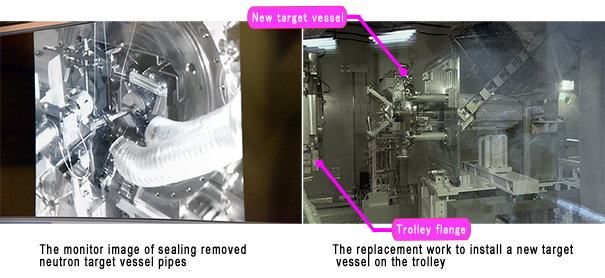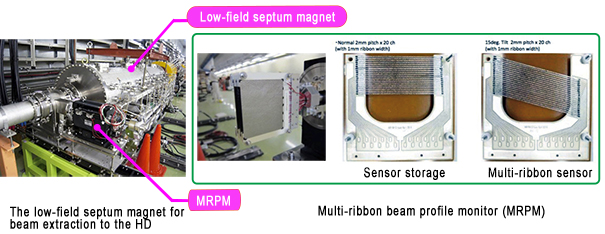| ” J-PARC News - October 2015 (Issue #126) |
Congratulations to Professor Takaaki Kajita for Receiving the 2015 Nobel Prize in Physics (October 6) - Discovery of Neutrino Oscillation Shows that Neutrinos Have Mass - |
|---|
| Professor Takaaki Kajita is Director of the Institute for Cosmic Ray Research, University of Tokyo, and through observation of atmospheric neutrinos using the Super-Kamiokande (SK) neutrino detector, located in Kamioka Village, Hida City, Gifu Prefecture, he discovered a phenomenon whereby muon neutrinos change to other types (Neutrino Oscillation) . He received the Nobel Prize in Physics in recognition of this work. Neutrinos are one kind of elementary particle, and they come in three types: electron, muon and tau. In the conventional theory of elementary particles, the mass of the neutrino has long been assumed to be 0 (zero), but this prize-winning research showed that neutrinos have a mass (although it is extremely small), and this has sparked a revolution in elementary particle theory.
Motivated by this discovery, researchers are actively carrying out experiments all over the world to investigate in detail what types of neutrinos change into other types.
Professor Kajita has been a core member of the T2K International Collaboration from its initial stages, and the group has been a strong driver of experiments using SK and the Neutrino Experimental Facility at J-PARC. In July 2013, the group reported at a meeting of the European Physical Society the discovery of an event in which a muon neutrino oscillated into an electron neutrino. At present, experiments are being conducted to elucidate the difference in properties between the particles and antiparticles of neutrinos (violation of CP symmetry) by using antineutrinos (antimatter neutrinos). Neutrino research is believed to hold the key to solving the riddle of the origin of matter in the universe, and research to achieve that goal is making steady progress at J-PARC. |
|
| This result was achieved through experiments by a collaborative research group including the Institute of Physical and Chemical Research (RIKEN) and the Comprehensive Research Organization for Science and Society (CROSS) . The experiments were conducted using the TAIKAN Small and Wide Angle Neutron Scattering Instrument (BL15) of the Materials and Life Science Experimental Facility. In this experiment, an oscillating magnetic field was applied and neutrons were irradiated while varying the stress on a MnSi alloy sample, and the change in the magnetic scattering pattern of neutrons was directly ascertained. In this way, the research elucidated the creation and deletion of magnetic vortices (skyrmions) . This result is expected to serve as a new guide toward development of next-generation memory using skyrmions. The research was featured in the October 13 issue of the international science journal Nature Communications. |
|
| On October 13-15, an international workshop was held to discuss the current status of elementary particle and nuclear physics using high-intensity proton accelerators such as J-PARC, plans for high-intensity beams in the megawatt class, and prospects for new domains opened up by such facilities. The workshop was held at the Ibaraki Quantum Beam Research Center, and was attended by more than 130 researchers from 12 countries. The first day was covered by NHK (Japan Broadcasting Corporation), and at the start of the meeting, there was a strong round of applause when Dr. Naohito Saito, Director of the J-PARC Center, reported that Professor Takaaki Kajita, Director of the Institute for Cosmic Ray Research, University of Tokyo, had received the Nobel Prize in Physics for his research on neutrinos. At this workshop, there were over 40 talks, as well as lively discussions, on topics such as accelerator facilities, their technology, high-intensity beam technology, and experiments in a wide range of fields using high-intensity beams. In the afternoon on the final day, participants toured the MLF, the Neutrino Experimental Facility, and the Hadron Experimental Facility.
During breaks in the conference, young researchers from outside Japan and Takashi Kobayashi, Head of the Particle & Nuclear Physics Division of J-PARC, were interviewed by the press regarding neutrino research such as the T2K experiments being carried out by an international research collaboration. |
|
| In recent years, silicon carbide (SiC) composite materials have achieved high density and good performance through an advanced fabrication technique called NITE (Nano-Infiltration and Transient Eutectic Phase), and as a result these composites have attracted attention world-wide. Recently, the Organization of Advanced Sustainability Initiative for Energy System/Material (OASIS) of Muroran Institute of Technology, which is conducting research and development in this area, held a workshop together with the J-PARC Center to explore the potential of such composites as accelerator materials. There were four introductory presentations by Muroran Institute of Technology and related persons on the current status of SiC composite development and the track record of using such materials, and five talks by J-PARC on topics such as the required performance of various basic materials, including the possibility using SiC composite materials in the muon production target (secondary particle target) at MLF, the MLF neutron source beam window, the beam window in the hadron beam line, and the 3-GeV synchrotron. There was valuable exchange of information between the participants. |
|
| A lecture on radiation safety was held as part of 2015 re-education and training for persons engaged in radiation work at J-PARC Center. A teleconferencing system was used to link with KEK Tsukuba. This time, Professor Shinji Tokonami of the Institute of Radiation Emergency Medicine of Hirosaki University was invited as the speaker, and he gave a talk on "Effects of Radiation Exposure on the Human Body: From the Fukushima Nuclear Power Plant Accident to Natural Radiation Exposure." The main topics of his talk were: basic knowledge of radiation, an overview of the Fukushima nuclear power plant accident, and current conditions of natural radiation exposure. To conclude, he said that, "We must act based on correct knowledge and judgment regarding radiation." Immediately after the Fukushima accident, Hirosaki University received a request from the Ministry of Education, Culture, Sports, Science and Technology, and it was decided to dispatch teaching staff to Fukushima, where they provided support to the people of Fukushima prefecture. After the lecture was finished, there was an explanation of precautions for persons engaged in radiation work at J-PARC by the staff member in charge of radiation safety at J-PARC, and the participants' degree of understanding of these precautions was confirmed. |
|
| (1) At the Materials and Life Science Experimental Facility (MLF), replacement of the neutron target vessel was carried out on September 28. The new vessel, with countermeasures to prevent recurrence of the problem which occurred with the previous neutron target vessel in April, was carried into the MLF on September 14, and at a later date it was moved to the irradiated components handling room where there was a cart for holding the target. Replacement of the target vessel was completed on the 28th. After that, a series of other tasks were carried out, including checking airtightness of the mercury circulation system and the cooling water pipe, and operation of the MLF resumed on October 27. |
 
 * Click here to enlarge. * Click here to enlarge. |
| |
| (2) At the 50 GeV synchrotron (MR), a multi-ribbon beam profile monitor (MRPM) was installed at the nearest upstream part of the low-field septum magnet for beam extraction to the Hadron Experimental Facility. By measuring the shape of the proton beam traveling around the MR, it is possible to achieve more efficient beam extraction to the experimental facility. |
 
 * Click here to enlarge. * Click here to enlarge. |
| |
| (3) At the Hadron Experimental Facility (HD), a muon transport solenoid magnet for the Coherent Muon to Electron Transition (COMET) experiment was carried in and installed on the 1st underground floor of the South Experimental Building, and there was a tour for persons involved in the experiment on October 21. |
|
| An origami class organized by the JAEA was held as part of cultural exchange activities with foreign researchers. A J-PARC user from overseas actively participated, and although this was a short class during the lunch break, the participants tried making a variety of creations under the guidance of the teacher. Some of the finished items were quite intricate, and one participant folded a samurai warrior helmet out of newspaper, put it on the head and warmly mixed with the Japanese participants. |
|
| The Ozora Marche is held every year by the Tokai Sightseeing Guide as an event for communicating the culture and history of Tokai Village to younger generations. The J-PARC Center participates by holding a "Science Experiment Corner" for promoting interaction with the local community, and boosting interest in science. This year, there were experiments featuring the "Frigid World" of liquid nitrogen at -196 and a "Super-Conducting Rollercoaster," and a new experiment with a "Running Battery" based on magnetism. These experiments were enjoyed by many children and their parents. A panel exhibit was viewed by many visitors interested in the neutrino experiment (T2K experiment) currently being conducted at J-PARC. This was partly due to Professor Kajita receiving the Nobel Prize for neutrino research this year. |
| |
| £to Page Top |
| |
|
©2015 J-PARC Center. All rights reserved.
|
|